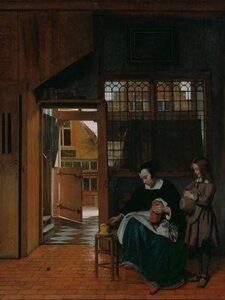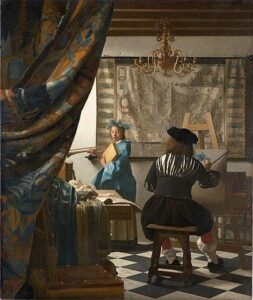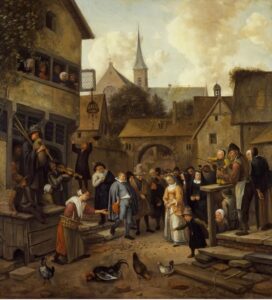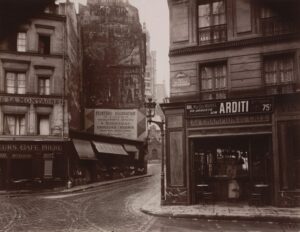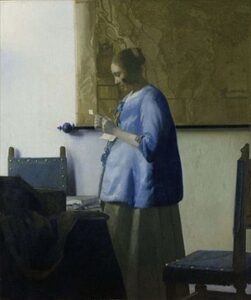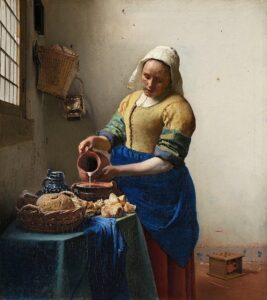Vermeer: objectivity, intimacy
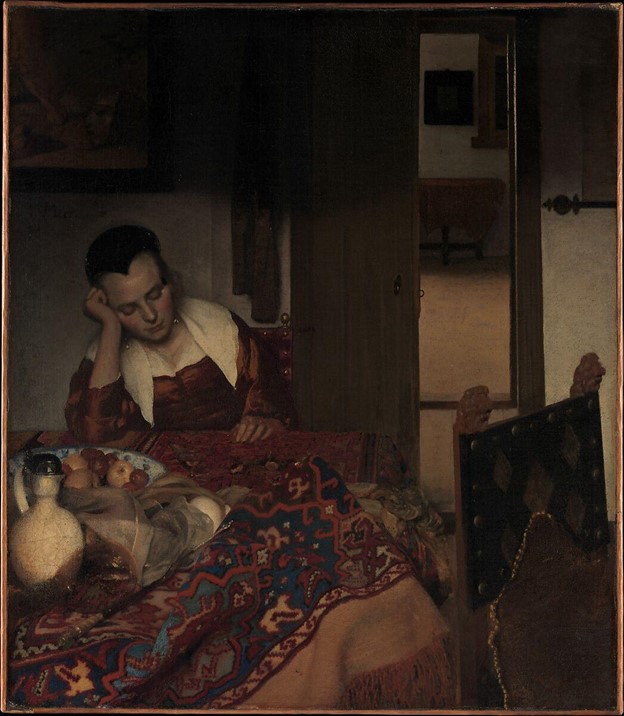
Johannes Vermeer, A Maid Asleep (c. 1656-7)
Sometime probably in 1656 or 1657, Johannes Vermeer painted a painting that we now know as A Maid Asleep. I reference this painting because it hangs at the Metropolitan Museum in New York City. I’ve looked at it many times. I have a relationship with this painting. I’ve loved it for years and for that same amount of time I’ve been trying to figure out why.
There is, as many people have pointed out, a sense of quiet and mystery to A Maid Asleep that’s quite visceral. You just feel it. The overall mood of the painting is established, obviously, by the image of the half-sleeping maid resting her head on her hand. But the door opening into the room just behind, the spare room that beckons our gaze, this room is probably more important than the maid in creating the dreamily intriguing mood of this painting. The crucial factor here being a sense of revelation. The half-opened door reveals another room. The painting asks us to probe deeper, to look further. At the same time, it also suggests that there is nothing further to see. Because when we look into that back room, it’s just another room, another room that’s actually less interesting than the room we’re already in. So, this is a painting that structures itself like a revelation and then, simultaneously, pushes our probing minds and eyes back out onto the surface again. It is a painting that short-circuits itself, leaving the viewer fascinated and frustrated all at once.
That’s not an easy thing to do in a painting. It took Vermeer many years of experimentation to find just the right formula. In this, he studied the work of many of his contemporaries. Dutch painting in this era was interested, for whatever reason, in capturing something of the subtle quiet that seems to have emanated from the interiors of these middle class homes. A contemporary of Vermeer’s, Pieter de Hooch, painted, for instance, a scene not unlike A Maid Asleep with his A Woman Preparing Bread and Butter for a Boy.
Pieter de Hooch, A Woman Preparing Bread and Butter for a Boy (1660-63)
Not quite the same degree of silence and mystery as in the Vermeer, but the double reveal/non-reveal with the small half-opened door outside the first fully-opened door almost makes up for it. The painting shows us very little. But it goes through quite a bit of work to create a capacious feeling, an appreciation maybe, of the plenitude of small moments. Vermeer was laboring in this same tradition of painting, and maintained friendships and working relationships with other painters who were painting in a similar style.
Some of these painters got famous in their time and sold work for quite a lot of money. But not Vermeer. He had trouble selling his work. He was not especially celebrated in his time. He didn’t produce very many paintings. He lived the vast majority of his life in the provincial Dutch city of Delft. He died there in 1685 at forty-three years old. Vermeer was buried in the local church with little fanfare. His remaining paintings were sold off to pay debts. The work descended into near-complete obscurity.
Then, in the mid 19th century, the work was rediscovered. This was especially due to a French writer and critic named Étienne-Joseph-Théophile Thoré. Thoré decided that Vermeer had been unjustly neglected in the intervening centuries. He made it his personal mission to rectify the matter. Why Thoré became so enamored of Vermeer is hard to say exactly. Thoré himself, though a competent critic, never wrote anything especially insightful about Vermeer’s paintings, even though he stated again and again that Vermeer ought to be held up as one of the great masters of the Dutch Golden Age, a view that has become canon in the century and a half since Thoré began his pro-Vermeer campaign.
What was Thoré seeing that generations before him had not? It is impossible to prove, but some art historians have conjectured that the camera is what changed everything. That’s to say, by Thoré’s time, human beings had begun to look at images differently. We’d been introduced to the sharp and impassive eye of the camera through the production of daguerreotypes, calotypes, all the early forms of photographic image making. Suddenly, the paintings of Vermeer became intriguing in a way that they were not two centuries earlier.
This raises an obvious question. Why would the invention of photography make it easier and more interesting to look at Vermeer paintings? The answer is controversial among some art historians but really shouldn’t be. It is obvious and beyond any reasonable doubt that Vermeer painted most if not all of his paintings with the help of lenses, either by projecting images directly onto his canvases by means of camera obscura-like devices or through other means. The evidence is really quite incontrovertible and I’m not going to descend into the weeds debating it here. I can recommend the artist David Hockney’s book Secret Knowledge (discussed by Hockney here – 23 min) for those who are curious. It’s a study of how lenses and mirrors were essential to the creation of many of the great works of the Renaissance through the Baroque and the Dutch Golden Age.
The experts who tend to balk at the claim do so because they’ve fetishized the ‘hand of the artist’ and love to write long passages about the inimitable brushstrokes of this or that genius. Fine as far as it goes. But not very helpful in understanding the actual genius of artists like Vermeer. Vermeer was not a genius of the brushstroke. He was a genius of seeing, and in his case, of seeing in a new way and through technologies of image projection. In short, Vermeer had his socks knocked off by looking through the peephole of the small box-sized camera obscurae that were circulating around Holland in his time. I say had his socks knocked off for a specific reason.
Around 1668, Vermeer painted a work that now hangs in the Kunsthistorisches Museum in Vienna and has come to be known as The Art of Painting or, sometimes, The Allegory of Painting.
Johannes Vermeer, The Art of Painting (c. 1668)
We can say that this is a painting about painting for the simple reason that it shows us a painter in the act of painting. I don’t think it is going too far to say that the painter in this picture is a comical figure. His stringy hair and bunchy socks prove it, as does the rather overburdened scenario the painter has arranged for himself to paint. The young woman he is painting is holding too many objects. She can’t quite manage to carry both the large book and the wind instrument. The wreath on her head looks silly. And that, I think, is more or less the point of this picture. Dutch painting of Vermeer’s time was completely overloaded with weighty symbolism. At least, that seems to be the viewpoint Vermeer himself was trying to convey.
I suspect that something like the following happened to Vermeer, and to some of the artists in the circles in which Vermeer ran. They got a glimpse of the beautiful and shimmering images that were being created by the newest and sharpest lenses available in 17th century Holland. They were amazed. They became interested in creating images as simple and stunning as what they were seeing in a camera obscura. The extra work of loading their paintings full of symbolic references became tiresome.
Johannes Vermeer, The Little Street (c. 1657)
Vermeer’s The Little Street, for instance, is a painting that shows us a street in Delft more or less as we would see it through a lens. There are, otherwise, no specific symbols in the painting and nothing to decode. That’s probably why it didn’t make much of an impact on the eyes of your average Dutch person in the mid 17th century. They were not primed to see it, or to understand it visually. Compare this picture by Vermeer with a picture by Jan Steen painted around the same time and you’ll see what I mean.
Jan Steen, The Village Wedding (c. 1655)
Steen was a great painter and this is a lovely picture. But there is a cartoon-like arrangement of space in the picture. The house on the left bends in to further frame the human scene that unfolds for us at the center of the image. Steen has fiddled with space and perspective in order to heighten the narrative impact of the event. The buildings and objects strewn around the little street themselves seem to participate in the simultaneously charming and semi-ridiculous/lewd spectacle of this maiden being wedded to what can only be described as the village cad. Again, it is a great picture. And it’s loaded with symbolic content with which one can interpret the picture.
Now, go back to Vermeer’s picture of the little street. What event is being portrayed here? The honest answer here I think has to be, “there isn’t one.” Of course, you can step back and think about the picture if you like. You can reflect on the quiet importance of the domestic work that women were doing in the social structure of the time. You can spool out long discourses on the new forms of individualism created by Dutch commercial society in the mercantile age. But the painting, I think it is fair to say, resists any direct interpretation. It is not directly about anything. Not in the way that Steen’s painting is about a village wedding. It has no point other than simply showing us something. It shows us a little street in Delft on a particular day.
In this-and I’m far from the first person to make the comparison-Vermeer’s painting of the little street has much more in common with a photograph by someone like Eugène Atget than to anything Jan Steen ever painted. Here, for example, is a picture that Atget took in 1925.
Eugène Atget. Rue de la Montagne-Sainte-Geneviève (June 1925)
This picture has plenty of intrigue. The little street that winds its way from the foreground into the background, culminating in the rounded door at the farthest reach of the view, this is lovely stuff. One can imagine any number of stories about this spot, about the lives and the experiences that happen here. But the picture is also interestingly impassive. It shows what it shows, nothing less, nothing more.
Taking this point one step further, let’s just spend a few moments looking at a photograph by Hilda and Bernd Becher, the German artist who did so much to influence contemporary streams in fine art photography.
Bernd and Hilda Becher, Am Gosenbach, Niederschelderhütte, Germany (1961)
This is something like a documentary photograph. At its core, it records something. In this case, it records what the buildings of a small town in Germany looked like in 1961. Hilda Becher once said of the photographs by her and Bernd that, “You have to be honest with your object and to make sure you do not destroy it with your subjectivity, and yet remain involved at the same time.” That’s a nice way to put it. It is the “involvement” -one almost wants to say “involvement at a distance”-that makes this picture by the Bechers something more than what we might otherwise call “mere documentation.” It’s hard to put one’s finger on exactly what constitutes or creates this feeling of involvement. But it is there, just as it is also there in various pictures of Delft by Vermeer.
What I am saying here is that although Vermeer’s paintings, in their subject matter, are so calm and reflective, they are also downright revolutionary. Vermeer was rejecting the painterly language of his time and trying to create a style and approach to painting that could capture and convey the power of what he was seeing in the images created by what, to him, was a new technology. In this, he was doing something like photographic Neue Sachlichkeit (New Objectivity) three hundred years before the Bechers were doing it. We are able to appreciate these images today because of the ubiquity of lens-created images flooding our eyes at any given moment.
Vermeer’s images intrigue in the very way that a great photograph always intrigues. There is an uncanny objectivity to the camera eye. There’s no other way to put it. This objectivity, in the right hands, is also conducive to intimacy. That might seem counterintuitive. Don’t we need subjectivity to feel intimacy? Yes, that is one way to produce intimacy. Plenty of painters have taken this road. But the objective, impassive eye of the camera can also create a powerful sense of intimacy. That’s what Hilda Becher meant when she said that you don’t want to destroy the object with “your subjectivity.” You should instead be objective and the deeper meaning of the picture will somehow emerge from that objectivity. This involved objectivity is what Vermeer explored over and over again.
Here’s an example.
Johannes Vermeer, Woman Reading A Letter (c. 1663)
First of all, it is interesting to note that this painting clearly results from the impassive “camera eye” look. Vermeer made this picture with the help of a projected image of some kind. Look at the way that the chair sits there in the foreground on the right side, for instance. It’s the way that a camera frames perspective, not the painterly eye. The specific warbles and blurrings of focus in the picture are also the result of what lenses can do. Vermeer accepted these oddities of the lens precisely because he liked what they did. Otherwise he would not have kept them. The result is a picture in which we maintain a distance from, and a deep respect for, the privacy of the person we see. We will not learn very much about her letter. We don’t need to. We already know what it is like to read a letter that is important to us.
But what this painting asks of us, with its detachment and respect, is that we not try to interpret too much. Do not step closer, says Vermeer. Stay right where you are. It is her letter, not yours. And thus, almost magically, the objectivity of the picture also lends itself to a sense of care. That, I suspect, is why everyone now loves the paintings of Vermeer. We are, now, used to camera-produced objectivity and dispassion, unlike the people of the 17th and 18th centuries, who did not really understand how to look at Vermeer’s pictures. In being used to the camera eye, we are also able to appreciate the distance that it creates. We are able to appreciate what it does. We can be deeply involved in this scene of the woman reading her letter without destroying her experience with our own subjectivity.
Johannes Vermeer, Milkmaid (c. 1658)
Let’s look at one more Vermeer painting just to let this point about objectivity and involvement sink in. This one is personal to me. Once I listened to a talk by an eminent art historian about this painting. I found myself deeply disturbed by the talk and want to explain, for the record, why I think it is so wrong. The art historian, who shall remain nameless so as not to make this vindictive, and also so that the art historian can stand in for the many people who try to make these kinds of points, interpreted this painting as basically a “pin-up” from the 17th century. He did so partially by noting that the tiles at the base of the wall seem to depict various amorous adventures and therefore clue us in that we (but who is “we”?) are supposed to enjoy looking at this woman in anticipation of our own amorous adventures. I would like to suggest a different reading. Instead of leering, the painting asks that we maintain our distance from this woman and that we appreciate the care and attention with which she is pouring the milk and getting the other food items together for whatever meal is about to be had. The tiles are depicted at the base of the wall for the simple reason that they were there, in this very room Vermeer immortalized with this painting. That’s it. There are no symbols here. There is no deeper meaning.
If this picture contains an argument, it is the argument that a picture does not need to be anything more than what it is in order for us to have a profound experience. It has been noted that Vermeer went to great pains to reproduce every crack and pockmark on the wall behind the maid. This is as crucial to the beauty of the painting as anything else it shows. Vermeer did this, again, because the marks and cracks were there. They were there, and therefore deserved to be attended to. That’s what the camera lens had proved to Vermeer. The camera lens does not discriminate. It does not make the wall smoother than it actually was, it doesn’t leave out this or that blemish.
The minor miracle of this painting is that the extreme impassivity of the scene, the objectivity with which we behold the milkmaid and the room is simultaneously revealing of a tenderness that is almost overwhelming. Is it surprising that such objectivity and such involvement should be so inextricably entwined? I’d say that it is. But these are mysteries that the painting does not seek to solve. It seeks simply to accept the mysteries, to dwell in them, and to pass them on, which, in fact, the painting has been doing now for more than three hundred years, whether anyone notices or not, whether anyone gets it or not, whether anyone cares or not, because the care is in the picture itself.

